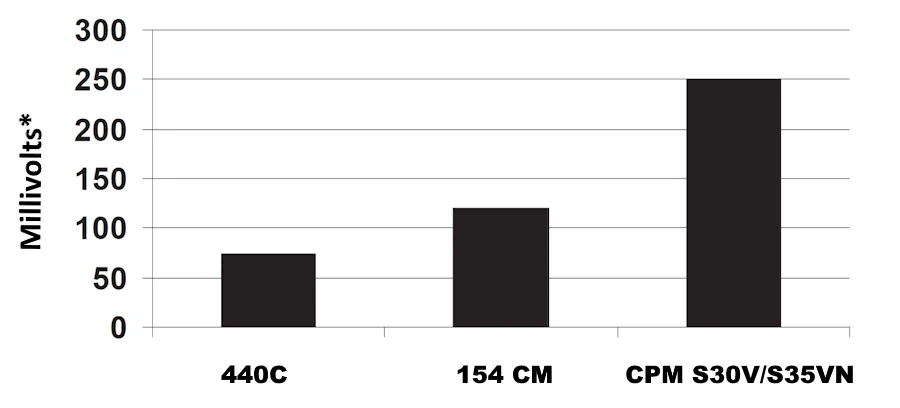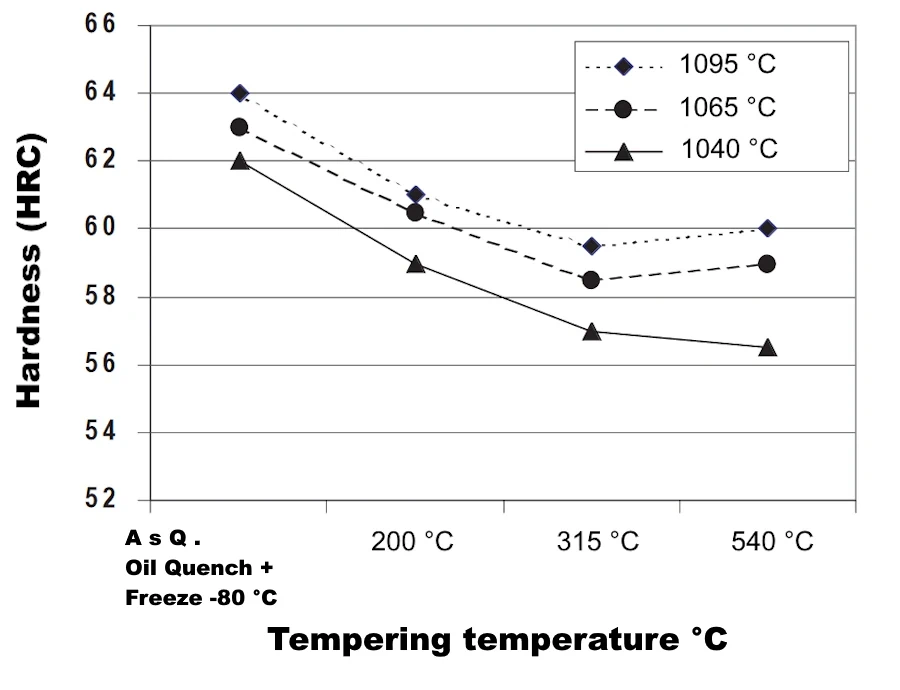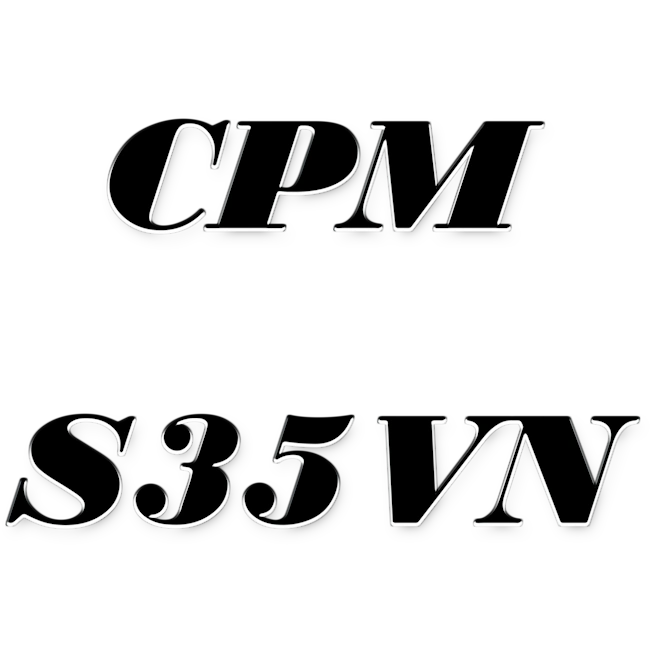CPM S35VN is a martensitic stainless steel designed to provide improved toughness over CPM S30V. It is also easier to machine and polish than CPM S30V. Its chemical composition has been rebalanced so that it forms some niobium carbides along with vanadium and chromium carbides. Replacing the niobium carbides with some vanadium carbides makes CPM S35VN approximately 15-20% tougher than CPM S30V without losing wear resistance.
The improved toughness of CPM S35VN gives it the best resistance to edge chipping. Since both vanadium and niobium carbides are harder and more effective than chromium carbides in providing wear resistance, CPM stainless blade steels provide improved edge retention compared to conventional high-chromium steels such as 440C and D2.
The CPM process produces highly homogeneous, high quality steel characterized by excellent dimensional stability, grindability and toughness compared to steels produced by traditional melting methods.
Overall, CPM S35VN is a high-performance stainless steel valued for its excellent balance of edge retention, toughness, and corrosion resistance. It is a popular choice for knives, hunting and fishing gear, and other cutting tools where performance and reliability are important.
CPM S35VN stainless steel made in the USA was first introduced in 2009 by Crucible Industries. Hardness 59 - 64 HRC.
Typical applications
- Special wear-resistant cutlery;
- Plastic injection and extrusion feed screws and dies;
- Check valve components;
- Pelletizing equipment;
- Wear-resistant components for food and chemical processing.
Note: these are some typical applications. Your specific program should not be accepted without independent research and assessment of suitability.
Chemical composition
Chemical composition of steel grade CPM S35VN | ||||||||||||
| C | Cr | Mo | V | Mn | Nb | Si | W | S | P | Co | Ni | Fe |
| 1,4 | 14,0 | 2,0 | 3,0 | 0,5 | 0,5 | 0,4 | 0,5 | 0,03 | 0,03 | 0,5 | 0,4 | Other |
Physical properties
- Modulus of elasticity: 221 hPa;
- Density: 7.47 g/cm3;
- Thermal conductivity at 93 °C: 17.31 W/m-°K;
- Coefficient of thermal expansion:
20 - 200 °C: 11.0X10-6 mm/mm/°C;
20 - 315 °C: 11.5X10-6 mm/mm/°C;
Mechanical properties
Longitudinal strength is around 25-28 ft-lbs, transverse strength of CPM grades is four or more times higher than 440C and 154CM. Higher transverse strength results indicate that CPM S35VN and CPM S30V are much more resistant to chipping and breaking in applications that may encounter lateral loading. In knife making, higher transverse strength makes CPM particularly suitable for large blades.
Edge retention
| Grade | % |
| CPM S35VN | 145* |
| CPM S30V | 145 |
| 154CM | 120 |
| 440C | 100 |
The CATRA (Cutlery & Allied Trades Research Association) test machine performs a standard cutting operation and measures the number of silica impregnated cards which are cut. It is considered a measure of relative wear resistance, reported in this table as compared to a 440C standard.
*Estimate based upon market feedback
Corrosion resistance
Average Pitting Potential measurements from Polarization Curves run in 5% NaCl (Sodium Chloride) Solution at Room Temperature: (Higher voltage pitting potential indicates better corrosion resistance.)

*vs. Hg/HgO reference electrode
Thermal treatments
- Forging: 1150 °C. Do not forge below 950 °C.
- Annealing: heat to 900 °C, hold for 2 hours, cool slowly at a rate of no more than 15 °C per hour to 595 °C, then cool in a furnace or in air to room temperature.
Annealed hardness: about BHN 255
Stress relieving
- Annealed parts: heat to 595 - 705 °C, hold for 2 hours, cool in a furnace or in air.
- Tempered parts: heat to 15 - 30 °C below the original tempering temperature, hold for 2 hours, then cool in a furnace or in air.
- Straightening: best done at 200 - 425 °C.
Hardening
- Preheating: heating to 845 - 870 °C. Leveling.
- Austenitize: 1035 - 1095 °C, holding time at temperature 15 - 30 minutes.
- Quench: air or positive pressure quench (2 bar minimum) to below 50 °C, or salt or interrupted oil quench to about 540 °C, then air cool to below 50 °C.
- Temper: double temper at 200 - 400 °C. Keep for at least 2 hours each time. Freezing can be used between the first and second tempering. Freezing helps to achieve maximum hardening and should always be followed by at least one temper.
NOTE: For optimum removal, CPM S35VN can be tempered at 540 - 550°C. Tempering in this range may result in reduced corrosion resistance. - Size change: +0.05 to +0.10% in martensitic condition. Presence of retained austenite may reduce net growth. When tempering at 200 - 400 °C, freezing may be required to minimize retained austenite.
Recommended heat treatment:
Austenitization at 1065 °C. Quenching to below 50 °C. Double tempering at 315 °C for at least 2 hours each. Cool to warm between temperings. Sub-zero temperature treatment may be added between temperings.
Aim hardness: 58-61 HRC.
Note: properties shown throughout this data sheet are typical values. Normal variations in chemistry, size and heat treat conditions may cause deviations from these values.
Heat treatment response - hardness (HRC) CPM S35VN | ||||||
| Austenitizing temperature | ||||||
| 1040 °C | 1065 °C | 1095 °C | ||||
| Oil | Oil + Freeze | Oil | Oil + Freeze | Oil | Oil + Freeze | |
| Tempering temperature | -80 °C | -80 °C | -80 °C | |||
| As Quenched | 60,5 | 62 | 62 | 63 | 63,5 | 64 |
| 200 °C | 57,5 | 59 | 57,5 | 60,5 | 59,5 | 61 |
| 315 °C | 57,5 | 57 | 59 | 58,5 | 59 | 59,5 |
| 540 °C | 57 | 56,5 | 59,5 | 59 | 58,5 | 60 |
| Results may vary with hardening method and section size. Salt or oil quenching will give maximum response. Vacuum or atmosphere cooling may result in up to 1-2 HRC points lower. | ||||||
| Minimum Time at Aust. Temp. | 30 min. | 30 min. | 15 min. | |||
| Minimum Number of Tempers | 2 | 2 | 2 | |||

Machinability and Grindability
In the annealed condition, CPM S35VN is much easier to machine than CPM S90V and easier to machine than CPM S30V. Similar grinding equipment and practices used for high speed steels are recommended. “SG” type alumina wheels or CBN wheels have generally given the best performance with CPM steels.
CPM S35VN is a premium martensitic stainless steel developed from CPM S30V steel by Chris Reeve and Dick Barber (Crucible Industries). The steel is known for its excellent balance of edge retention, toughness and corrosion resistance, making it a popular choice for high-end knives and other cutting tools.
